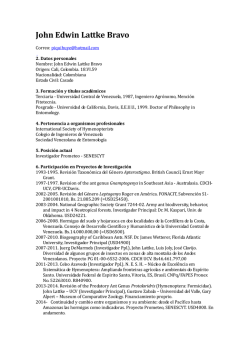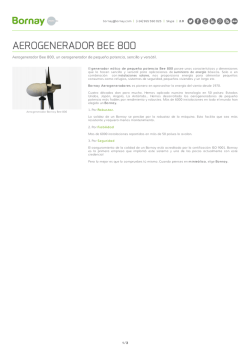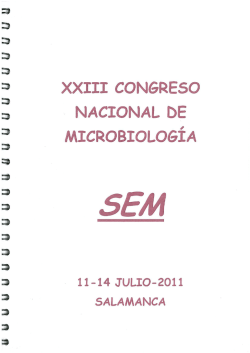
Notas del MEFLG - Facultad de Ciencias
BOLETIN DEL MUSEO ENTOMOLÓGICO FRANCISCO LUÍS GALLEGO Notas del MEFLG Guillermo de Jesús Guarín Candamil1, John Alveiro Quiroz-Gamboa2 Becario MEFLG. Estudiante Ingeniería Agronómica, Universidad Nacional de Colombia Sede Medellín. 2Tecnico/Curador, Museo Entomológico Francisco Luís Gallego, Universidad Nacional de Colombia, Sede Medellín. 1 Trámite de registro del MEFLG, ante Instituto de Investigación de Recursos Biológicos “Alexander von Humboldt”. En visita realizada por la funcionaria del Área Metropolitana del Valle de Aburra, el 15 de agosto de 2015 entre las 8:30 am y las 12:45 de la tarde, se realizó una revisión de las actividades que están contempladas en el decreto Nº1375 del 27 de junio de 2013 del Ministerio de Ambiente y Desarrollo Sostenible, “Por el cual se reglamentan las colecciones biológicas”, artículo 12. Seguimiento y Evaluación, cuya competencia directa es del Instituto de Investigación de Recursos Biológicos “Alexander von Humboldt”. Producto de esta vista se recomienda la ejecución de una serie de tareas relacionadas a continuación: Informar al Sistema Hermes, que en presencia de la funcionaria de la autoridad ambiental, Control y Vigilancia del Grupo Fauna, del Área Metropolitana del Valle de Aburrá, que el museo se encuentra en proceso de aprobación y actualización del registro ante el Instituto de Investigación de Recursos Biológicos “Alexander von Humboldt”. Cuya información de actualización de registro fue enviada por el MEFLG el pasado 24 de Octubre de 2014. Como se puede observas en correo enviado a la funcionaria del sistema Hermes, Martha Liliana Correa O (figura 1). 31 Volumen 7 • Número 2 Junio • 2015 Figura 1. Pantallazo del correo enviado a Marta Liliana Correa, Funcionaria del Sistema Hermes. Trámite de control y vigilancia, Grupo Fauna del Área Metropolitana del Valle de Aburrá. En el registro del Instituto de Investigación de Recursos Biológicos Von Humboldt, aparece como como contacto del MEFLG, una persona que no tiene ningún vínculo legal con el museo (figura 2). Figura 2. Formato electrónico del RNC, donde aparece el contacto del MEFLG. 32 BOLETIN DEL MUSEO ENTOMOLÓGICO FRANCISCO LUÍS GALLEGO Impresión de las normas de protocolo del museo, con sus respectivos procedimientos en cada uno de los formatos que se tienen dispuestos para tales actividades (figura 3). Figura 3. Formato de préstamo de material del MEFLG. Figura 4. Formato de visitas y de donación de material del MEFLG. 33 Volumen 7 • Número 2 Junio • 2015 Figura 5. Formato de canje de material MEFLG. Encuadernar los listados donde están diligenciados todos los formatos que utiliza el museo para los procedimientos de préstamo, revisiones etc., hacerle la rotulación oficial con membrete de la universidad y el logo o nombre oficial del museo. Ordenar de manera cronológica los ingresos y egresos de material del museo, de forma consecutiva desde el año 2013 hasta el presente, discriminando aquí todos los movimientos del museo. Eventos Día Internacional de los Museos 18 de mayo Entre el 4 y el 29 de mayo del 2015 se realizó la exposición fotográfica “Membrácidos, maravillas de la evolución” por Francisco Antonio Arango Ceballos en el Espacio del Hombre, de la Biblioteca Efe Gómez de la Universidad Nacional de Colombia Sede Medellín, y con ella celebrar el Día Internacional de los Museos, el cual está declarado por la UNESCO el 18 de mayo. El lema de la celebración internacional de éste año fue Museos para una sociedad sostenible. Apoyaron la División de Bibliotecas y la Facultad de Ciencias. 34 BOLETIN DEL MUSEO ENTOMOLÓGICO FRANCISCO LUÍS GALLEGO 35 Volumen 7 • Número 2 Junio • 2015 Agradecimientos María Eugenia Tabares Duque, Evelyn Pérez, Estudiantes Ingeniería Agronómica, Beneficiarias Programa Promotores de Convivencia Universidad Nacional de Colombia Sede Medellín, Guillermo de Jesús Guarín- Candamil, Becario MEFLG, Estudiante Ingeniería Agronómica, Universidad Nacional de Colombia Sede Medellín. ALGUNOS COMENTARIOS DE LOS VISITANTES A LA EXPOSICIÓN 36 BOLETIN DEL MUSEO ENTOMOLÓGICO FRANCISCO LUÍS GALLEGO Nuevas Publicaciones con el material del MEFLG A new paracolletine bee from Colombia (Hymenoptera: Colletidae), with an updated checklist of the tropical Andean bee fauna. Journal of Melittology, Bee Biology, Ecology, Evolution, & Systematics. The latest buzz in bee biology. No 43, pp. 1-26, 2014. Victor H. Gonzalez¹, Rita I. Velez-Ruiz², Michael S. Engel3-4 1 Undergraduate Biology Program, Haworth Hall, 1200 Sunnyside Avenue, University of Kansas, Lawrence, Kansas 66045-7566, USA ([email protected]). 2 South Dakota State University, Plant Sciences Department, Agricultural Hall, 1010 Rotunda Lane, Brookings, South Dakota 57007, USA (ritaisavelez@gmail. com). 3 Division of Entomology, Natural 37 Volumen 7 • Número 2 Junio • 2015 History Museum, and Department of Ecology & Evolutionary Biology, 1501 Crestline Drive – Suite 140, University of Kansas, Lawrence, Kansas 66045- 4415, USA ([email protected]). 4 Division of Invertebrate Zoology, American Museum of Natural History, Central Park West at 79th Street, New York, New York 100245192, USA ([email protected]). Cameron, 1903 (Hymenoptera: Halictidae) from Colombia. Zootaxa 3786(5): 574–586. Abstract. A new species of the paracolletine genus Lonchopria Vachal, Lonchopria (Biglossa) comforti Gonzalez & Engel, new species, from high elevations in the Central Andes of Colombia is described and figured. A preliminary key to the species of the Lonchopria subgenus Biglossa Friese is presented. Recent records of bees occurring at elevations above 2500 m in Colombia and other Andean countries are also summarized. Coloma-Roman LA. 1986. Contribución para el conocimiento de las abejas sin aguijón (Meliponinae, Apidae, Hymenoptera) de Ecuador. Undergraduate thesis, Pontificia Universidad Católica del Ecuador; Quito, Ecuador. 146 p. References Ascher JS, Engel MS, Griswold TL. 2006. A new subgenus and species of Oxaea from Ecuador (Hymenoptera: Andrenidae). Polskie Pismo Entomologiczne 75(4): 539–552. Bonilla MA. 1990. Abejas euglosinas de Colombia (Hymenoptera: Apidae). Undergraduate thesis, Universidad Nacional de Colombia; Bogotá, Colombia. 130 p. Brooks RW, Engel MS. 1999. A revision of the Augochlorine bee genus Chlerogas Vachal (Hymenoptera: Halictidae). Zoological Journal of the Linnean Society 125(4): 463–486. Celis CJ, Cure JR, Aguilar-Benavides ML. 2014. Two new species of Caenohalictus 38 Chavarría G. 1996. Systematics and behavior of the neotropical bumble bees (Hymenoptera: Apidae: Bombus). Ph.D. dissertation, Harvard University; Cambridge, MA. 250 p. Cruz S. 1996. Abejas carpinteras de Colombia (Hymenoptera: Apidae). Undergraduate thesis, Universidad Nacional de Colombia; Bogotá, Colombia. 223 pp. Engel MS. 1996. Taxonomic and geographic notes on some halictine bee species (Hymenoptera: Halictidae). Journal of the New York Entomological Society 104(1–2): 106–110. Engel MS. 1999. A new species of the bee genus Neocorynura from the Andes of Ecuador (Hymenoptera, Halictidae, Augochlorini). Spixiana 22(2): 173–178. Engel MS. 2000. Classification of the bee tribe Augochlorini (Hymenoptera: Halictidae). Bulletin of the American Museum of Natural History 250: 1–192. Engel MS. 2001. A monograph of the Baltic amber bees and evolution of the Apoidea (Hymenoptera). Bulletin of the American Museum of Natural History 259: 1–192. BOLETIN DEL MUSEO ENTOMOLÓGICO FRANCISCO LUÍS GALLEGO Engel MS. 2007. Two new Augochlorine bees from Ecuador (Hymenoptera: Halictidae). Acta Entomologica Slovenica 15(1): 21–29. Engel MS. 2009a. Notes on the Augochlorine bee genus Chlerogas (Hymenoptera: Halictidae).Caldasia 31(2): 449–457. Engel MS. 2009b. Revision of the bee genus Chlerogella (Hymenoptera, Halictidae), part I: Central American species. ZooKeys 23: 47–75. Engel MS. 2010a. The bee genus Chlerogas in Bolivia (Hymenoptera, Halictidae). ZooKeys 46: 61–70. Engel MS. bee genus Halictidae), species and 47: 1–100. Engel MS, Rasmussen C. 2013. Revision of the bee genus Chlerogella (Hymenoptera: Halictidae), Part III: New records and a new species from Peru. Journal of Melittology 9: 1–8. Engel MS, de Oliveira FF, SmithPardo AH. 2006. A new species of the bee genus Chlerogas Vachal from Ecuador (Hymenoptera: Halictidae). Entomologist’s Monthly Magazine 142(1703–1705): 103–106. Gonçalves RB, Engel MS. 2010. The bee genus Caenaugochlora (Hymenoptera, Apoidea) and its constituent subgenera, with new species of Caenaugochlora s.str. from Ecuador. ZooKeys 37: 69–80. 2010b. Revision of the Chlerogella (Hymenoptera, part II: South American generic diagnosis. ZooKeys Gonzalez VH. 2004. A new species of Acamptopoeum from Colombia (Hymenoptera: Andrenidae: Panurginae). Caldasia 26(1): 239–243. Engel MS. 2011. Systematic melittology: Where to from here?. Systematic Entomology 36(1): 2–15. Gonzalez VH. 2006. Dos especies nuevas de abejas de la ciudad de Bogotá (Colombia). Revista Colombiana de Entomología 32(1): 93–96. Engel MS. 2013. The bee genus Ischnomelissa in Peru, with a key to the species (Hymenoptera: Halictidae). Journal of Melittology 23: 1–5. Engel MS, Gonzalez VH. 2009. A new species of Chlerogas from the Andes of central Colombia (Hymenoptera: Halictidae). Caldasia 31(2): 441–447. Engel MS, Klein BA. 1997. Neocorynurella, a new genus of the Augochlorine bees from South America (Hymenoptera: Halictidae). Deutsche Entomologische Zeitschrift 44(2): 155–163. Gonzalez V.H., Chávez F. 2004. Nesting biology of a new Andean bee, Anthophora walteri Gonzalez (Hymenoptera: Apidae: Anthophorini). Journal of the Kansas Entomological Society 77(4): 36–44. Gonzalez VH, Engel MS. 2004. The tropical Andean bee fauna (Insecta: Hymenoptera: Apoidea), with examples from Colombia. Entomologische Abhandlungen 62(1): 65–75. Gonzalez VH, Engel MS. 2011. Andinopanurgus, a new Andean subgenus of Protandrena (Hymenoptera, Andrenidae). ZooKeys 126: 57–76. 39 Volumen 7 • Número 2 Junio • 2015 Gonzalez VH, Engel MS. In press. A new species of Lonchopria Vachal from Norte de Santander, Colombia (Hymenoptera: Colletidae). In: Aguiar AJC, Gonçalves RB, Ramos KS (eds). Ensaios sobre as abelhas da região Neotropical: Homenagem aos 80 anos Danuncia Urban. Editora UFPR. Gonzalez VH, Florez J. 2011. Leioproctus rosellae sp. n., the first record of the genus from northern South America (Hymenoptera, Colletidae). ZooKeys 141: 71–77. Gonzalez VH, Giraldo C. 2009. New Andean bee species of Chilicola Spinola (Hymenoptera: Colletidae, Xeromelissinae) with notes on their biology. Caldasia 31(1): 145–154. Gonzalez VH, Griswold T. 2013. Wool carder bees of the genus Anthidium in the Western Hemisphere (Hymenoptera: Megachilidae): Diversity, host plant associations, phylogeny, and biogeography. Zoological Journal of the Linnean Society 168(2): 221‒425. Gonzalez VH, Michener CD. 2004. Applications of specific names and association of sexes in Cadegualina (Hymenoptera, Colletidae, Diphaglossini). Proceedings of the Entomological Society of Washington 106(4): 850–856. Gonzalez VH, Nates-Parra G. 1999. Sinopsis de Parapartamona (Hymenoptera: Apidae: Meliponini), un género estrictamente andino. Revista de la Academia Colombiana de Ciencias Exactas, Físicas y Naturales 23(Suplemento especial): 171–179. 40 Gonzalez VH, Ruz L. 2007. New enigmatic Andean bee species of Protandrena (Hymenoptera: Andrenidae), with notes on their biology. Revista Brasileira de Entomologia 51(4): 397–403. Gonzalez VH, Vélez D. 2007. Una especie nueva de Paratrigona (Hymenoptera, Apidae, Meliponini), con una sinopsis del género en Colombia. Boletín del Museo de Entomología de la Universidad del Valle 8(2): 9–13. Gonzalez VH, Sepúlveda P. 2007. Una especie nueva de Geotrigona (Hymenoptera, Apidae, Meliponini), con comentarios del género en Colombia. Acta Biológica Colombiana 12S: 107– 112. Gonzalez VH, Smith-Pardo AH, Bogotá G. 2006. Two new Andean species of Neocorynura (Hymenoptera: Halictidae: Augochlorini) with notes on their biology. Studies on Neotropical Fauna and Environment 41(3): 197–208. Gonzalez VH, Rasmussen C, Velázquez A. 2010. Una especie nueva de Lestrimelitta y un cambio de nombre en Lasioglossum (Hymenoptera: Apidae, Halictidae). Revista Colombiana de Entomología 36(2): 319–324. Gonzalez VH, Rasmussen C, Engel MS. 2013a. Incasarus garciai, a new genus and species of panurgine bees from the Peruvian Andes (Hymenoptera: Andrenidae). Journal of Melittology 8: 1‒9. Gonzalez VH, Griswold T, Engel MS. 2013b. Obtaining a better taxonomic understanding of native bees: Where do we start?. Systematic Entomology 38(4): BOLETIN DEL MUSEO ENTOMOLÓGICO FRANCISCO LUÍS GALLEGO 645–653. Gonzalez VH, Rasmussen C, Engel MS. 2014. A new species of Liphanthus from Peru (Hymenoptera: Andrenidae). Journal of Melittology 31: 1–9. Grimaldi D, Engel MS. 2007. Why descriptive science still matters. BioScience 57(8): 646–647. Hurd PD Jr. 1978. An Annotated Catalog of the Carpenter Bees (Genus Xylocopa Latreille) of the Western Hemisphere (Hymenoptera: Anthophoridae). Smithsonian Institution Press; Washington, DC; 106 p. Liévano A, Ospina R. 1984. Contribución al conocimiento de los abejorros sociales de Cundinamarca. Undergraduate thesis, Universidad Nacional de Colombia; Bogotá, Colombia. 163 p. Michener CD. 1989. Classification of the American Colletinae (Hymenoptera, Apoidea). University of Kansas Science Bulletin 53(1): 622–703. Michener CD. 2000. A high Andean subgenus and species of Hylaeus (Hymenoptera, Colletidae). Journal of the Kansas Entomological Society 73(1): 1–5. Michener CD. 2002. The bee genus Chilicola in the tropical Andes, with observations on nesting biology and phylogenetic analysis of the subgenera (Hymenoptera, Colletidae, Xeromelissinae). Scientific Papers, Natural History Museum, University of Kansas 26: 1–47. Michener CD. 2007. The Bees of the World [2nd Edition]. Johns Hopkins University Press; Baltimore, MD. 953 p. Moure JS. 1949. Notas sobre algunas abejas de Tacanas, Tucumán, Argentina. II. (Hymenopt. Apoidea). Revista de Entomologia 20(1– 3): 437–460. Moure JS. 1956. Duas espécies de Megachile de grandes altitudes (Hymenopt.-Apoidea). Dusenia 7(2): 103–106. Moure JS, Hurd PD Jr. 1987. An Annotated Catalog of the Halictid Bees of the Western Hemisphere. (Hymenoptera: Halictidae). Smithsonian Institution Press, Washington, DC. 405 p. Moure JS, Urban D. 2002. Catálogo de Apoidea da região Neotropical (Hymenoptera, Colletidae). III. Colletini. Revista Brasileira de Zoologia 19(1): 1–30. Nates-Parra G, Gonzalez VH, OspinaTorres R. 1999. Descripción de los machos y anotaciones sobre la biología de Paratrigona anduzei y P. eutaeniata (Hymenoptera: Apidae: Meliponini) en Colombia. Caldasia 21(2): 174–183. Packer L. 1993. Two distinctive new species of halictine bees from high altitude in the New World tropics (Hymenoptera: Halictidae). Canadian Journal of Zoology 71(8): 1653–1662. Parra HA, Nates-Parra G. 2007. First record of Eufriesea bare Gonzalez & Gaiani and notes on the distribution of three species of orchid bees pertaining to the genus Euglossa Latreille (Apidae: 41 Volumen 7 • Número 2 Junio • 2015 Euglossini) in Colombia. Revista de la Academia Colombiana de Ciencias Exactas, Físicas y Naturales 31(120): 415‒423. Raw A. 2002. synonymies of bees of the Hymenoptera, 71: 1–43. New combinations and leafcutter and mason Americas (Megachile, Megachilidae). Zootaxa Roig-Alsina A. 1999. Revisión de las abejas colectoras de aceites del género Chalepogenus Holmberg (Hymenoptera, Apidae, Tapinotaspidini). Revista del Museo Argentino Ciencias Naturales 1: 67–101. Smith-Pardo AH, Gonzalez VH. 2009. A revision of Neocorynura bees of the joannisi group, with new geographical records for other rare Andean species (Hymenoptera: Halictidae, Augochlorini). Studies on Neotropical Fauna and Environment 44 (2): 115–129. Urban D. 1967. As espécies do genero Thygater Holmberg, 1884. Boletim da Universidade Federal do Paraná (Zoologia) 2: 177–307. Urban D. 1971. As espécies do genero Alloscirtetica Holmberg, 1909 (Hymenoptera, Apoidea). Boletim da Universidade Federal do Paraná (Zoologia) 3: 307–370. Urban D. 1977. Espécies novas de Alloscirtetica Holmberg, 1909 (Hymenoptera, Apoidea). Dusenia 10(1): 1–14. Urban D. 2001. Espécies novas de Anthidium Fabricius do Chile, Argentina e Perú (Hymenoptera, Megachilidae). 42 Revista Brasileira de Zoologia 18(2): 539–550. Urban D, Moure JS. 2001. Catálogo de Apoidea da região Neotropical (Hymenoptera, Colletidae). II. Diphaglossinae. Revista Brasileira de Zoologia 18(1): 1–34. Urban D, Moure JS. 2002. Catálogo de Apoidea da região Neotropical (Hymenoptera, Colletidae). IV. Hylaeinae. Revista Brasileira de Zoologia 19(1): 31– 56. New record and re-description of a gall-forming aphid (Hemiptera: Aphididae), commonly confused in the north of South America, associated with an ant (Hymenoptera: Formicidae). Agronomia Colombiana. Volume XXXIII. No 1, January-April 2015 113p. Ronald Simbaqueba-Cortés¹, Francisco Serna¹, Erika Valentina Vergara-Navarro¹, and John Alveiro Quiroz-Gamboa² 1 Sistemática de Insectos Agronomía (SIA); Línea Taxonomía de Insectos de Importancia Agrícola; Museo Entomológico UNAB, Faculty of Agricultural Sciences, Universidad Nacional de Colombia. Bogota (Colombia). [email protected]. co 2 Museo Entomológico “Francisco Luis Gallego” (MEFLG), Faculty of Sciences, Universidad Nacional de Colombia. Medellín (Colombia). Abstract The gall-forming aphid Tetraneura fusiformis is recorded for the first time for northern South America. Its identity BOLETIN DEL MUSEO ENTOMOLÓGICO FRANCISCO LUÍS GALLEGO is clarified, and descriptions of this species and that of T. nigriabdominalis, with which it is commonly confused, are offered. The association of this sap sucking insect with the ant Linepithema angulatum (Hymenoptera: Formicidae) is recorded for the first time as well. and information guide. 2nd ed. J. Wiley & Sons, Chichester, London. 476 p. Key words: invasive species, insectsplants, taxonomy, trophobiosis. Bustillo AE, Sánchez G. 1977. Los áfidos en Colombia: plagas que afectan los cultivos agrícolas de importancia económica. Instituto Colombiano Agropecuario (ICA), Bogotá. Resumen Se registra por primera vez para el norte de Sudamérica el pulgón formador de agallas de las raíces Tetraneura fusiformis. Su identidad es precisada y se ofrecen las descripciones de esta especie y de T. nigriabdominalis, con la cual es comúnmente confundida. También se registra por primera vez la asociación de este insecto chupador de savia con la hormiga Linepithema angulatum (Hymenoptera: Formicidae). Palabras clave: especies invasoras, insecto-planta, taxonomía, trofobiosis. Literature cited Akimoto S. 1985. Taxonomic study on gall aphids, Colopha, Paracolopha and Kaltenbachiella (Aphidoidea: Pemphigidae) in East Asia, with special reference to their origins and distributional patterns. Insecta Matsumurana. New Series 31: 1-79. Blackman RL, Eastop VF. 1994. Aphids on the world’s trees. An identification guide. CAB International, Wallingford, UK. 1024 p. Blackman RL, Eastop VF. 2000. Aphids on the world’s crops. An identification Blackman RL Eastop VF. 2006. Aphids on the world’s herbaceous plants and shrubs. Host lists and keys. Vol. 1. J. Wiley & Sons, Chichester, UK. 1439 p. Cermeli M. 1970. Los áfidos (Homoptera, Aphididae) de Venezuela y sus plantas hospederas. Agronomía Tropical 20(1): 249-256. Delabie JHC. 2001. Trophobiosis between Formicidae and Hemiptera (Sternorrhyncha and Auchenorrhyncha): an overview. Neotropical Entomology 30: 501-516. Delfino MA. 2005. Inventario de las asociaciones áfido-planta en el Perú. Ecological Aplication 4: 143-158. Foottit RG, Maw HEL, Pike KS, Messing RH. 2012. Aphids (Hemiptera: Aphididae and Adelgidae) of Hawai‘i: Annotated list and key to species of an adventive fauna. Pacific Science. 66: 1-30. ICA, Instituto Colombiano Agropecuario. 1972. Notas y noticas entomológicas ICA. Bogota. Longino JT. 2010. The Ants of Costa Rica. In: The Evergreen State College. Disponible en http://academic. evergreen.edu/projects/ants/home. htm. Consultado en Mazo de 2015. 43 Ortego J, Difabio ME, Mier Durante MP. 2004. Nuevos registros y actualización de la lista faunística de los pulgones (Hemiptera: Aphididae) de la Argentina. Revista de la Sociedad Entomológica de Argentina 63: 19-30. Posada L. 1989. Lista de insectos dañinos y otras plagas en Colombia. Technical Bulletin No. 43. Instituto Colombiano Agropecuario (ICA), Bogotá. Posada-Flórez FJ, Téllez-Farfán L, Simbaqueba R, Serna F. 2014. Reconocimiento y observaciones bionómicas de Sipha flava (Hemiptera: Aphididae) atacando el pasto kikuyo en dos zonas de Colombia. Revista UDCA Actualidad y Divulgación Científica. 17: 95-104. Quiros DI, Emmen DA. 2006. Diversidad biológica de los áfidos (Hemiptera: Aphididae) de Panamá. Tecnociencia 8: 63-75. Sano M, Akimoto SI. 2011. Morphological phylogeny of gall-forming aphids of the tribe Eriosomatini (Aphididae: Eriosomatinae). Systematic Entomology 36: 607-627. Serna F, Mackay W. 2010. A descriptive morphology of the ant genus Procryptocerus (Hymenoptera: Formicidae). Journal of Insect Science 10 (111): 1-36. Simbaqueba R, Serna F, Posada-Flórez FJ. 2014. Curaduría, morfología e identificación de áfidos (Hemiptera: Aphididae) del Museo Entomológico UNAB. Primera aproximación. Boletín Científico Museo de Historia Natural 18: 222-246. Velasco C, Corona-Vargas MC, PeñaMartínez R. 2007. Liometopum apiculatum (Formicidae: Dolichoderinae) y su relación trofobiotica con Hemiptera Sternorrhyncha en Tlaxco, Tlaxcala, México. Acta Zoológica Mexicana 23: 31-42. Villalobos W, Pérez N, Mier MP, Nieto JM. 2010. Aphididae (Hemiptera: Sternorrhyncha) from Costa Rica, with new records for Central America. Boletín de la Asociación Española de. Entomología 34: 145-182. Wild, A.L. 2007. Taxonomic revision of the ant genus Linepithema (Hymenoptera: Formicidae). Vol. 126. University of California Press, Berkeley, CA. Taxonomic status and redescription of Magneuptychia nebulosa (Butler, 1867) (Lepidoptera, Nymphalidae, Satyrinae) with a lectotype designation. Zookeys 503: 135-147p 2015. Shinichi Nakahara1, Mario Alejandro Marín2,3, Cristóbal Ríos-Málaver4,5 1 McGuire Center for Lepidoptera and Biodiversity, Florida Museum of Natural History, University of Florida, Gainesville, FL 32611, USA. 2 Grupo de Investigación en Sistemática Molecular, Universidad Nacional de Colombia, Sede Medellín. Calle 59A No 63-20. Bloque 16-112 Medellín, Colombia. 3 Departamento de Biologia Animal, Instituto de Biologia, Universidade Estadual de Campinas (UNICAMP), Cidade Universitaria– Zeferino Vaz, Caixa Postal 6109, Barão Geraldo 13083-970. 4 Grupo de investigación en Ecología y Biogeografía, Universidad de Pamplona, Colombia. 5 BOLETIN DEL MUSEO ENTOMOLÓGICO FRANCISCO LUÍS GALLEGO Laboratorio de Biología de Organismos, Centro de Ecología, Instituto Venezolano de Investigaciones Científicas (IVIC), km 11 vía Panamericana Altos de Pipe, Apartado postal 20632, Caracas, 1020A Abstract A redescription of Magneuptychia nebulosa (Butler, 1867), a poorly known euptychiine butterfly, is given here, and accurate distributional data are provided for the first time. Taxonomic status of this taxon has been discussed by comparing its morphology against its possible congeners. In addition, lectotype designation for M. nebulosa is provided in order to objectively establish the identity of this taxon and consequently stabilize the nomenclature. Resumen Se presenta una redescripción de Magneuptychia nebulosa (Butler, 1867), una mariposa euptychina poco conocida y se brinda por primera vez datos de su distribución. Se discute el estatus taxonómico de este taxón por comparación de su morfología con la de posibles congéneres. En adición, se provee un lectotipo para M. nebulosa, en búsqueda de establecer objetivamente la identidad de este taxa y consecuentemente estabilizar su nomenclatura. Keywords Euptychiina, Neotropical, Venezuela, Morphology Taxonomy, Palabras claves Euptychiina, Neotropical, Venezuela, Morfología Taxonomía, Referencias Brévignon C. 2005. Description de nouveau Satyrinae provenant de Guyane française (Lepidoptera, Nymphalidae). Lambillionea 105 3(1): 393–404. Brévignon C, Benmesbah M. 2012. Complément à l’inventaire des Satyrinae de Guyane (Le pidoptera: Nymphalidae). In: Lacomme D, Manil L (Eds) Lépidoptères de Guyane. Tome 7. Nymphalidae. Association des Lépidoptéristes de France, Paris. 36–52. Brown KS, Mielke OHH. 1967. Lepidoptera of the Central Brazil plateau. I. Preliminary list of Rhopalocera: Introduction, Nymphalidae, Libytheidae. Journal of the Lepidopterists’ Society 21(2): 77–106. Butler AG. 1867. A monograph of the genus Euptychia, a numerous race of butterflies belonging to the family Satyridae; with descriptions of sixty species new to science, and notes to their affinities, etc. Proceedings of the Zoological Society of London 1866(3): 458–504. D’Abrera B. 1988. Butterflies of the Neotropical Region. Part 5. Nymphalidae (conc.). Satyrinae Victoria, Black Rock, Hill House. 679–877. Forster VW. 1964. Beitrage zur Kenntnis der Insecktenfauna Boliviens XIX. Lepidoptera 3, satyridae. Veröffentlichungen der Zoologischen Staatssammlung München 8: 51–188. Godman FD, Salvin O. 1880. Biologia Centrali-Americana. Insecta. Lepidoptera-Rhopalocera. Dulau & Co., Bernard Quaritch, London 1: 73–88. Klots AB. 1956. Lepidoptera. In: Tuxen 45 SL (ed.) Taxonomist’s Glossary of Genitalia in insects. Ed. 2. Munksgard, Copenhagen. 97–111. Lamas G. 2004. Nymphalidae. Satyrinae. Euptychiina, Checklist: Part 4A. Hesperioidea – Papilionoidea. In: Heppner JB (Ed.) Atlas of the Neotropical Lepidoptera. Volume 5A. Association for Tropical Lepidoptera/Scientific Publishers, Florida. 439 p. Viloria AL, Pyrcz TW, Orellana A. 2010. A survey of the Neotropical montane butterflies of the subtribe Pronophilina (Lepidoptera, Nymphalidae) in the Venezuelan Cordillera de la Costa. Zootaxa 2622: 1–41. Warren AD, Davis KJ, Stangeland EM, Pelham JP, Grishin NV. 2014. Illustrated Lists of American Butterflies. Disponible en http://www.butterfliesofamerica.com Consultado en Noviembre de 2014. Miller LD. 1968.The higher classification, phylogeny and zoogeography of the Satyridae (Lepi doptera). Memoirs of the American Entomological Society 24: 1–174. Weymer G. 1911. Familie: Satyridae. In: Seitz A (ed.) Die Gross-Schmetterlinge der Erde. A. Kernen, Stuttgart 5: 209– 216. Miller LD. 1970. Nomenclature of wing veins and cells. Journal of Research on the Lepidoptera 8 (2): 37–48. Donación de material bibliográfico Muschamp PAH. 1915. The Ci-devant genus Epinephele. The Entomologist’s Record and Journal of Variation 27: 152–156. Neild AFE. 1996. The Butterflies of Venezuela. Part1: Nymphalidae (Limenitidinae, Apaturinae, Charaxinae). A comprehensive guide to the identification of adult Nymphalidae, Papilionidae, and Pieridae. Meridian Publications, Greenwich, London. 144 p. Peña C, Nylin S, Freitas AVL, Wahlberg N. 2010. Biogeographic history of the butterfly subtribe Euptychiina (Lepidoptera, Nymphalidae, Satyrinae). Zoologica Scripta 39 (3): 243–258. Peña C, Lamas G. 2005. Revision of the butterfly genus Forsterinaria Gray, 1973 (Lepidoptera: Nymphalidae, Satyrinae). Revista Peruana de Biología 12: 5–48. Hormigas cortadoras de hojas de Colombia: Acromyrmex & Atta (Hymenoptera: Formicidae) FAUNA DE COLOMBIA – Monografía No. 5. Universidad Nacional de Colombia Sede Bogotá, Facultad de Ciencias, INSTITUTO DE CIENCIAS NATURALES. Fernando Fernández, Valentina CastroHuertas & Francisco Serna. 350p. CALDASIA 36 (1) Junio 30 de 2014. INSTITUTO DE CIENCIAS NATURALES – MUSEO DE HISTORIA NATURAL FACULTAD DE CIENCIAS – UNIVERSIDAD NACIONAL DE COLOMBIA 216p. CALDASIA 36 (2) Diciembre 30 de 2014. INSTITUTO DE CIENCIAS NATURALES – MUSEO DE HISTORIA NATURAL FACULTAD DE CIENCIAS – UNIVERSIDAD NACIONAL DE COLOMBIA 216-410p. BOLETIN DEL MUSEO ENTOMOLÓGICO FRANCISCO LUÍS GALLEGO BOLETÍN DEL MUSEO ENTOMOLÓGICO FRANCISCO LUÍS GALLEGO ISSN 2027-4378 Apartado Aéreo 3840 Teléfono: 430 9830 Medellín, Colombia http://www.unalmed.edu.co/~mentomol/ 47
© Copyright 2026




